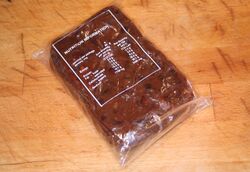Tamarind paste is the fruit pulp of the tamarind tree (Tamarindus indica). The fruit pulp is edible and popular. It is used as a spice in Indian, Chinese and other Asian cuisines. It is also popular in Latin America. It is an important ingredient in Worcestershire sauce, HP sauce and the Jamaican-produced Pickapeppa sauce. The hard green pulp of a young fruit is very tart and acidic and is most often used as a component of savoury dishes. The ripened fruit is sweeter, yet still distinctively sour, and can be used in desserts and sweetened drinks, or as a snack. In Thailand, there is a carefully cultivated sweet variety with little to no tartness grown specifically to be eaten as a fresh fruit.

The leaves are also distinctly tart in flavour, and are used in many soups in the North Eastern part of Thailand.
In temples, especially in Asian countries, the pulp is used to clean brass shrine furniture, removing dulling and the greenish patina that forms.
Types available
Processed tamarind is generally available as pulp, concentrate and paste. The pulp sometimes comes as a pure pulp, sometimes with stones, skins and other impurities. The stones are very hard and will break teeth so remove them before using! Soak the pulp in a little boiling water for 15 minutes, then stir and strain so you are left with a pure tamarind 'stock'.
Aqua de Tamarindo
Agua de tamarindo is an agua fresca drink from Mexican cuisine. It is made with tamarind after it has been boiled in water, has had its seeds removed, and has been liquified and combined with sugar. (If your mixture comes out too acidic you may need to dilute it more with water or use less Tamarindo.) It is typically sold at taquerías and typical cuisine restaurants in Mexico. It has gained popularity in other Latin American countries, as well as in Mexican populations in the United States and elsewhere.
Find recipes that contain 'Tamarind paste'
#tamarindpaste #mexicancuisine #worcestershiresauce #hpsauce